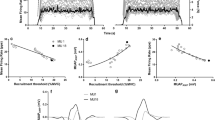Abstract
The recruitment order of motoneurons of first dorsal interosseous (1DI) muscle has been shown to be the same during either isometric abduction or flexion of the index finger. However, it is not known whether this stereotyped recruitment is the same for all functional tasks. This question was addressed by using the 1DI muscle, which contributes to many functional tasks involving the hand and fingers. Single motor units and surface electromyographic activity were recorded from 1DI in three human subjects. Each subject performed tasks of abduction of the index finger, rotation to unscrew a threaded knob and pincer to close a springloaded clip. The same motor units were activated for each of the three tasks, providing no evidence for the existence of task groups. The order of recruitment of pairs of selected motor units was the same for each of the three tasks.
Similar content being viewed by others
References
Bawa P, Lemon RN (1993) Recruitment of motor units in response to transcranial magnetic stimulation in man. J Physiol (Lond) 471:445–464
Bigland B, Lippold OCJ (1954) The relationship between force, velocity and integrated electrical activity in human muscle. J Physiol (Lond) 123:214–224
Brown SHC, Cooke JD (1981) Amplitude and instruction dependent modulation of movement related electromyogram activity in humans. J Physiol (Lond) 316:97–107
Buller NP, Garnett R, Stephens JA (1980) The reflex responses of single motor units in human hand muscles following muscle afferent stimulation. J Physiol (Lond) 303:337–349
Calancie B, Bawa P (1985a) Firing patterns of human flexor carpi radialis motor units during the stretch reflex. J Neurophysiol 53:1179–1193
Calancie B, Bawa P (1985b) Voluntary and reflexive recruitment of flexor carpi radialis motor units in humans. J Neurophysiol 53:1194–1200
Calancie B, Bawa P (1990) Motor unit recruitment in humans. In: Binder MD, Mendell LM (ed) The segmental motor control system. Oxford University Press, New York, pp 75–95
Desmedt JE, Godaux E (1977) Fast motor units are not preferentially activated in rapid contractions in man. Nature 267:717–719
Desmedt JE, Godaux E (1978) Mechanisms of the vibration paradox: excitatory and inhibitory effects of tendon vibration on single soleus muscle motor units in man. J Physiol (Lond) 285:197–207
Desmedt JE, Godaux E (1981) Spinal motoneuron recruitment in man: deordering with direction, but not with speed of voluntary movement. Science 214:933–936
Flament D, Goldsmith P, Buckley CJ, Lemon RN (1993) Task dependence of response in first dorsal interosseous muscle to magnetic brain stimulation in man. J Physiol (Lond) 464:361–378
Henneman E (1957) Relation between size of neurons and their susceptibility to discharge. Science 126:1345–1347
Henneman E, Shahani BT, Young RR (1976) Voluntary control of human motor units. In: Shahani M (ed) Motor systems: neurophysiology and muscle mechanisms. Elsevier, Amsterdam, pp 73–78
Jones KE, Bawa P, McMillan AS (1993) Recruitment of motor units in human flexor carpi ulnaris. Brain REs 602:354–356
Lawrence JH, DeLuca J (1983) Myoelectric signal versus force relationship in different human muscles. J Appl Physiol 54:1653–1659
Lemon RN, Mantel GWH, Rea PA (1990) Recording and identification of single motor units in the free-to-move primate hand. Exp Brain Res 81:95–106
Milner-Brown HS, Stein RB (1975) The relation between the surface electromyogram and muscular force. J Physiol (Lond) 246:549–569
Milner-Brown HS, Stein RB, Yemm R (1973) The orderly recruitment of human motor units during linearly changing voluntary contractions. J Physiol (Lond) 230:359–370
Monster AW, Chan H (1977) Isometric force production by motor units of extensor digitorum communis muscle in man. J Neurophysiol 40:1432–1443
Palmer SS, Fetz EE (1985) Discharge properties of primate forearm motor units during isometric muscle activity. J Neurophysiol 54:1178–1193
Riek S, Bawa P (1992) Recruitment of motor units in human forearm extensors. J Neurophysiol 68:100–108
Schieber MH (1993) Muscular production of individuated finger movements. Soc Neurosci Abstr 19:2283
Thomas CK, Ross BH, Stein RB (1986) Motor unit recruitment in human first dorsal interosseous muscle for static contractions in three directions. J Neurophysiol 55:1017–1029
Thomas CK, Ross BH, Calancie B (1987) Human motor unit recruitment during isometric contractions and repeated dynamic movements. J Neurophysiol 57:311–324
Author information
Authors and Affiliations
Rights and permissions
About this article
Cite this article
Jones, K.E., Lyons, M., Bawa, P. et al. Recruitment order of motoneurons during functional tasks. Exp Brain Res 79, 503–508 (1994). https://doi.org/10.1007/BF00229189
Received:
Accepted:
Issue Date:
DOI: https://doi.org/10.1007/BF00229189




